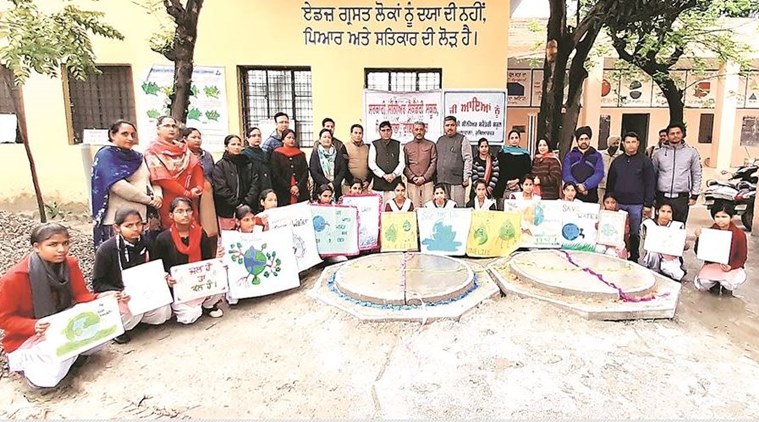 The project has been replicated is 33 schools, and can help revive depleted groundwater levels. (Express photo)
The project has been replicated is 33 schools, and can help revive depleted groundwater levels. (Express photo)
For 9-year-old Diya, a class V student in the Government Elementary School, Kila Bairoon, a rainy day would always mean no school as each downpour would leave her classroom flooded.
But not anymore, because her school now has a rainwater recharging system. Asked what she knows about this facility, she says, “The rainwater that collects on the rooftops is directed downwards to the soil through pipes laid from rooftop to the ground. On the ground, there are two tanks. The rainwater goes into the first tank, where it gets filtered, and then goes to the second tank. This filtered water then makes its way into the soil.” “We should do this in our homes to save water,” Diya adds.
Gagandeep Singh, a class V student in the same school, says water recharging can save groundwater. “Our teachers explained to us that whatever water we extract, we can send it back into the soil,” he adds.
This system has not only rid the school of its perennial waterlogging problem, it has also garnered much interest among the students who are now, even in their young age, aware of the concept of water recharging.
Hoshiarpur Assembly constituency has become a torchbearer for rainwater recharging, having set up such projects in the premises of 33 government schools (17 primary and 16 middle, high and senior secondary) over the past 4-5 months. The work will continue to cover the 95 schools falling under this constituency.
It took a village local MLA and Minister Sunder Sham Arora took up this project after the idea was floated by elementary school teacher Deepak Vashishth, who teaches at the Kila Bairoon school.
The minister formed a committee which included Vashisth, District Education Officers (Secondary and Elementary) Mohan Singh Lohal and Sanjiv Gautam, Deputy DEO Deeraj Vashisth, and Divisional Soil Conservation Officer Naresh Gupta. The then local SDM Amit Sareen and then deputy commissioner Isha Kalia got the work executed first at Kila Bairoon and three other schools.“The minister arranged Rs 6 lakh for the three schools – Kila Bairoon, Government Secondary School and Government Primary School, Piplanwal village, which were in the worst condition during rain.
Later, the same projects were executed in 30 other schools,” said Vashisth. A Rs 66 lakh grant was released for this purpose as each such project costs Rs 2 lakh and the minister funded it through funds allocated to him as well as collected from some industry members under the Social Responsibility Programme. The soil conservation department provided all the technical support and a company was hired for installation.
A teacher’s idea
“The problem of waterlogging in my school, which is located in a low-lying area and is small (less than 1,000 sq yards area), led to the idea of installing a rainwater recharging project. During the rains, children used to slip while walking to school and were forced to sit in waterlogged classrooms,” said Deepak Vashisth.“We made a list of 33 schools first where rain was a hurdle,” the teacher said, adding that it has not only saved wastage of rainwater but also enlightened students about the importance of water as a resource.
“Now we are also planning to start rainwater harvesting in other schools where more space is available. We will get big tanks constructed there so extra rainwater can be stored to be used for irrigation as well as for cleaning the school premises instead of extracting groundwater for this purpose,” he further said.
A minister’s goals
“When this problem of waterlogging came to my knowledge through the school teachers, I decided to install this project in other schools facing the same issue,” said Minister Arora, adding that his main aim is to improve the condition of government schools.“I am going to execute this rainwater harvesting project in all government schools of Hoshiarpur Assembly constituency and if there are any other schools from other constituencies that would like to try this out I will get it done there too,” said Arora, adding that this will not only stop mosquito breeding in schools but also revive groundwater levels to a great extent.
He said he also got Reverse Osmosis (RO) systems installed in 69 schools of his own constituency and outside it at a cost of nearly Rs 20,000 each where groundwater had been polluted, and got toilets built in over a dozen schools.
On a larger scale
To install such projects in every government school building – there are over 19,000 in Punjab — would be a huge shot in the arm for the state where over 76 per cent blocks fall in the ‘dark zone’ in terms of underground water stock. Punjab’s surface water resources could be exhausted in the next 25 years if the area under the water-guzzling paddy crop is not diversified to other less water consuming crops. However, various diversification policies have failed so far.Experts are stressing on installation of rainwater harvesting/rainwater re-charging projects in every commercial and domestic establishment, but here too Punjab has failed.But these 33 government schools have now given many fresh hope.